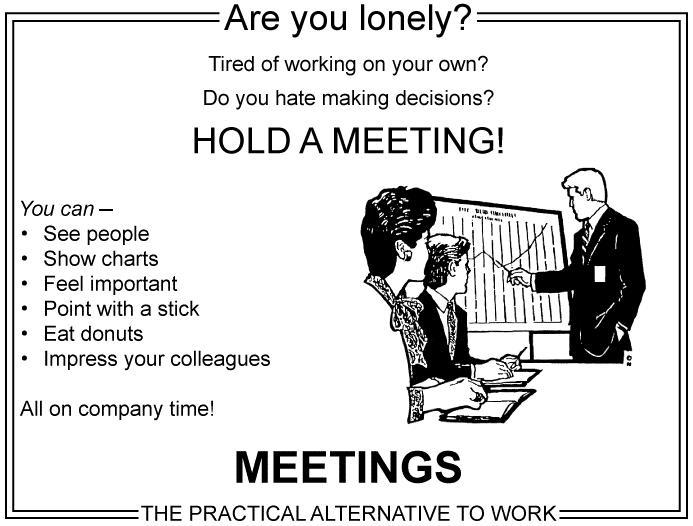by Anne Krueger
Grossmont-Cuyamaca Community College District
El Cajon, CA

There are few things worse in our workday than a bad meeting. When I’m at a meeting that isn’t going well, my mind wanders. I start thinking about all the work I could be doing at my desk or what I’ll be making for dinner tonight. I begin pondering my next move on Words with Friends or planning my vacation — ANYTHING but wasting time in this boring meeting.

It doesn’t have to be that way. Done right, meetings can be productive and accomplish real goals while still making everyone in the group satisfied that they were able to contribute to the conversation.
I run a few meetings in our college district, and I’ve developed some strategies for leading a successful meeting. They’re good reminders of how to keep your meetings on track.
1) Have a clear purpose for your meeting. Do you even need to meet? Can your issues be resolved in a quick phone call or email? Also, don’t be tied to the rule that a meeting must last at least an hour. If you can make a decision in 15 minutes, no one will be upset that the meeting ended early.
2) Make sure the right people are at your meeting. If you need a college vice president to make decisions, they need to be part of the discussion. Don’t rely on trying to explain to them later the decisions that the group reached.
3) Let it be known that you will start the meeting on time. You’ll find that people are much more likely to arrive on time when they know they won’t be sitting around waiting for a meeting to start. I’m a stickler about starting my meetings precisely on time, so my committee members know they should be there a couple of minutes before the scheduled start time. It’s OK if someone is running late and shows up after the meeting starts – but those of us who arrived on time are already deep into discussion. Meetings should also end at the specified time, or sooner, if all business has been discussed.
4) For major issues, meet one-on-one with committee members before a meeting. In this way, you can answer any questions and allay any doubts, and you’ll have a sense of which way committee members are leaning before the meeting starts.
5) Include action items in the meeting notes. In addition to stating the needed action, the item should also include who will be undertaking the action. At the end of the meeting, review the action items so everyone is aware of what is expected of them before the next meeting.
6) Offer thanks and praise to your committee members. Make people feel good about taking time out of their busy schedule to attend your meeting. Compliment the people who fulfilled their assignments from the last meeting, or someone who took initiative to resolve an issue that the group was facing.
7) Be conscious of the people who aren’t speaking up at a meeting. Offer everyone an opportunity to speak. They may be a person who is hesitant to interrupt and jump into the flow of a discussion – even though they may have great ideas.
If students are part of the meeting, make a special effort to seek their input. The rest of you are being paid to attend the meeting. Students are there because they care about your college. They might have a perspective that employees never thought about.
8) Distribute the meeting notes within a week of the meeting. Meeting notes will remind everyone of the tasks they have agreed to perform and will ensure that the next meeting is on their calendar.
Meetings are a necessary evil for our jobs, but they can serve a good purpose if done purposefully. Happy meetings!
Anne Krueger is the communications and public information director for the Grossmont-Cuyamaca Community College District in eastern San Diego County, California.


STAY CONNECTED